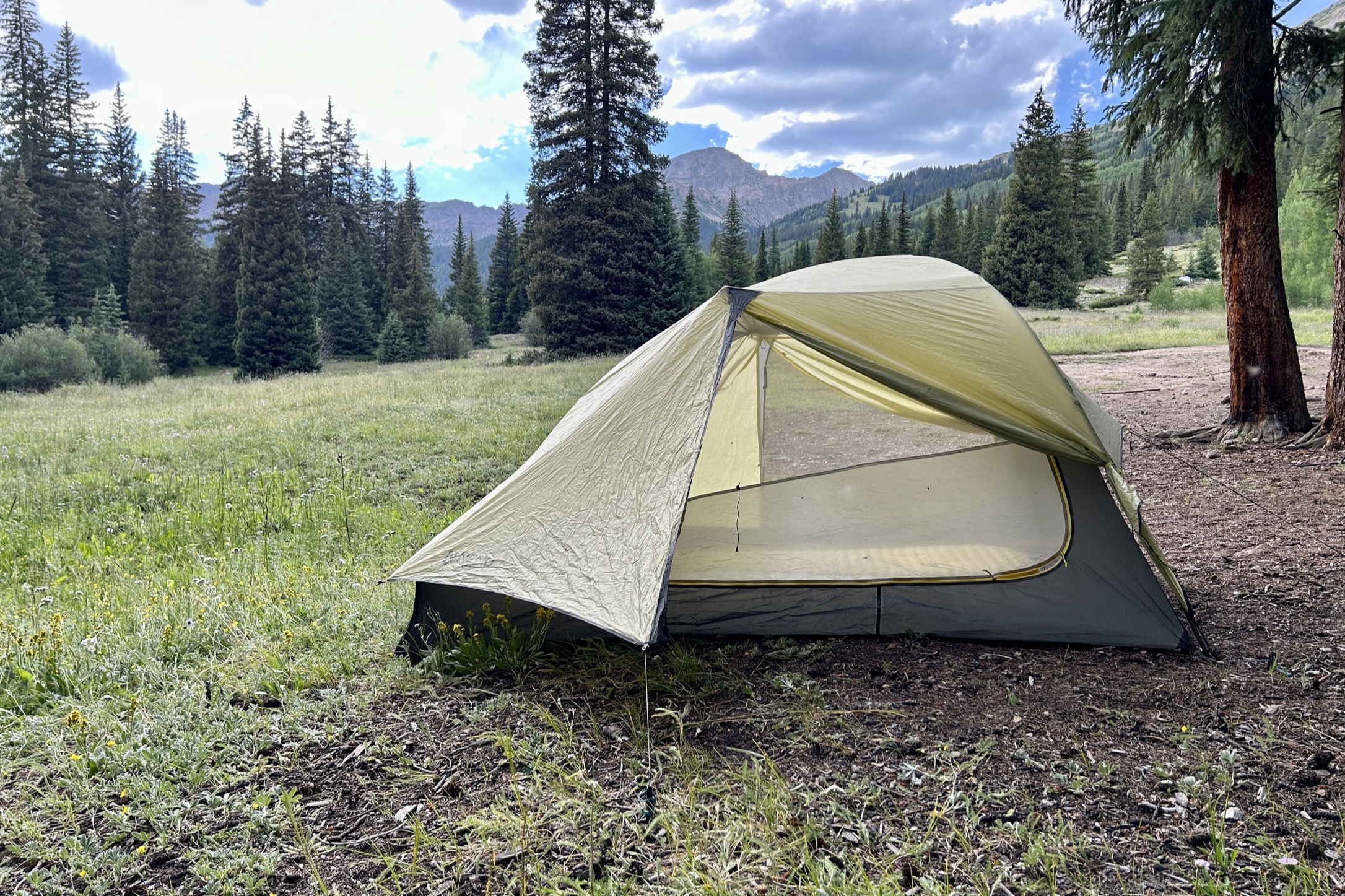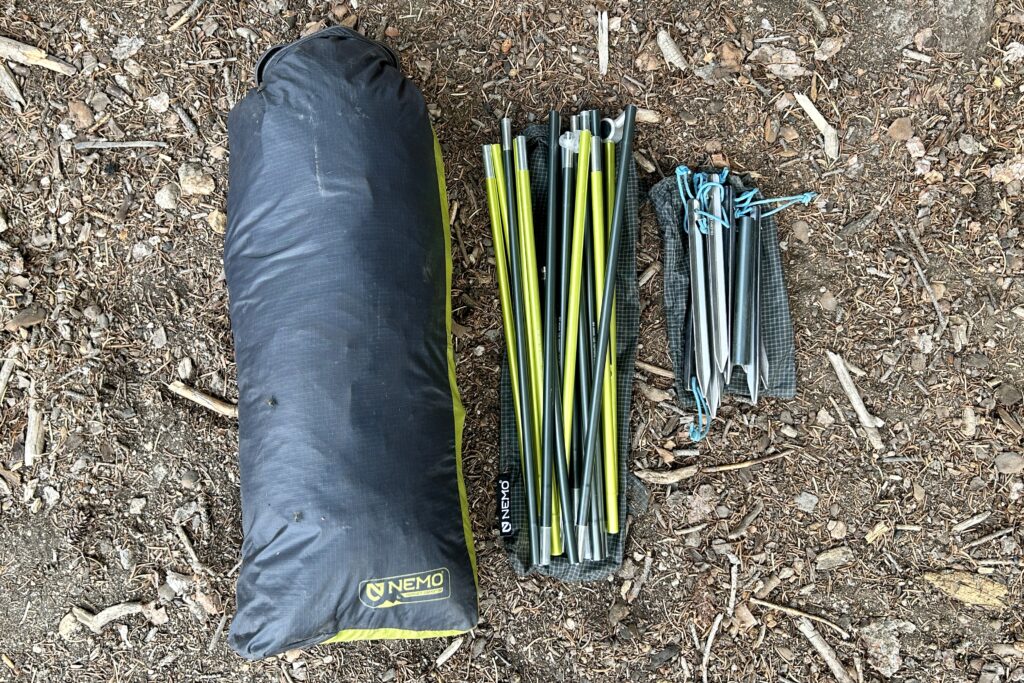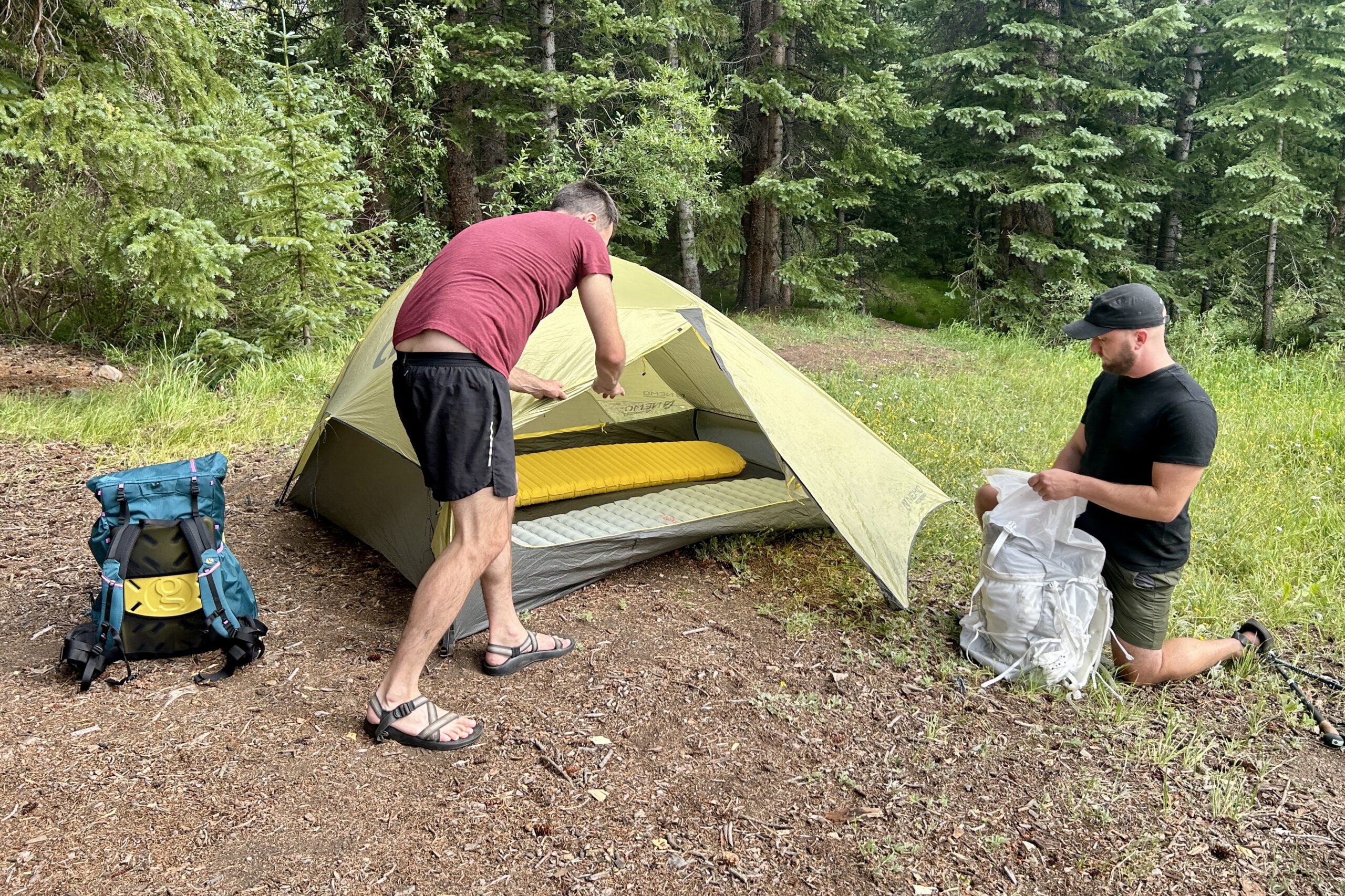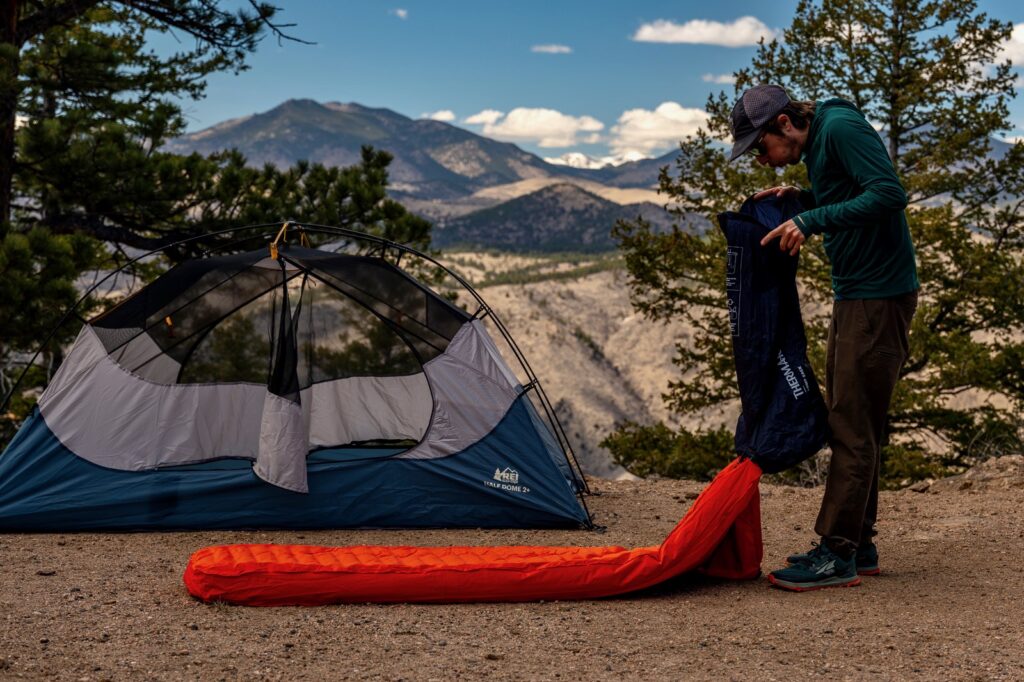
Bottom Line
The NEMO Hornet OSMO 3 is a standout lightweight backpacking tent that’s built for comfort and full of features. CleverHiker Founder, Dave Collins, used this tent on backpacking trips throughout the Wallowa Mountains and North Cascades. And the Hornet 3 is a go-to for Gear Analyst Ian Krammer when backpacking in the Colorado Rockies in summer.
The Hornet 3 is a palace in the backcountry with two broad doors, large vestibules for gear storage, and a huge interior that will easily accommodate two wide sleeping pads and tons of gear. The proprietary OSMO fabric repels water with ease, but maintains a taut pitch in wet conditions to keep you dry and cozy inside the tent. And the Hornet 3’s weight is still very reasonable for hikers who want to keep their pack weight to a minimum. NEMO’s attention to detail is evident in the tent’s high-quality construction and plentiful interior pockets.
However, the tent does have some limitations. The semi-freestanding design means that it requires careful staking for maximum stability, especially when the wind picks up. It’s also too snug for three people to sleep comfortably, making it best for two with extra gear or a dog instead of a trio. And, the price is on the higher side, which might deter budget-conscious backpackers.
Quick Specs

NEMO Hornet OSMO 3
Great Option for UL Hikers Wanting More Space
CleverHiker Rating: 4.6/5.0
Price: $530
Packed Weight: 3 lb. 5 oz.
Dimensions (LxWxH): 88 x 68/62 x 44 in.
Type: Semi-freestanding
Pros
- Ultralight for the size
- Well-priced for the specs
- Very roomy for two
- Convenient pockets
- High-quality materials/construction
- Good ventilation
- Innovative stuff sack makes it easy to split the load
Cons
- Expensive
- Rainfly zippers can snag
- Only one side of rainfly doors can be tied back

Comfort
Ultralight doesn’t have to mean sacrificing comfort. With the NEMO Hornet OSMO 3, a pair of hikers can have the conveniences of a traditional 2-person tent – two doors and vestibules, a roomy interior, and useful pockets – without the additional weight. It’s got a ton of room inside – we regularly fit two people, a dog, and all of our gear without feeling cramped – thanks to steep sidewalls and plenty of headroom. The generous floor dimensions and peak height easily fit two wide sleeping pads, so you’ll have plenty of room to toss and turn and spread out.
Dialed-in features like NEMO’s Nightlight Pockets disperse your headlamp light in a soft, even glow thanks to a large overhead pocket to create a super cozy atmosphere inside the tent. Plus, the tent has a huge gear loft pocket that makes it easy to hide clutter, and well-placed side pockets give you dedicated spots for smaller items, from chargers to pocket knives. As an added bonus, this spacious shelter costs around the same amount of money as many of the leading 2-person backpacking tents.
The Hornet OSMO 3 might not be quite long enough for tall hikers over 6’3,” but other than that, we don’t really have many qualms about the comfort of this tent. It’s a very roomy and comfortable tent for two people.

Weight & Packability
At only 3 pounds, 5 ounces, the Hornet 3 is very lightweight for a 3-person tent, and still pretty light for a 2-person tent. This is a great choice for backpackers who want to balance weight and space. This semi-freestanding style reduces the number of tent pole sections, which contributes to its lighter weight, and its double-wall Ripstop Nylon construction makes it extremely packable.
The reasonable packed size can be compressed even farther using NEMO’s innovative Divvy stuff sack. This stuff sack allows you to efficiently divide the tent’s components inside the bag with a separate section for poles and stakes, fly and tent. This is a small but awesome design feature that’s helpful for splitting the weight of the tent between two hikers or for staying organized while solo. The easy-to-stow design enhances overall packability and usability in the backcountry.
However, while the Hornet 3’s weight is very reasonable, it’s not the lightest option compared to some semi-freestanding and non-freestanding models we’ve tested. If your top priority is minimizing weight, you may want to check out some of the options on our Best Ultralight Tent list. There’s usually a tradeoff for going lighter though, so you’ll likely have to sacrifice interior space or convenience if you want to save more weight.
Similarly, the packed size of the Hornet 3 is quite reasonable, but it’s still a bit bulkier than many non-freestanding ultralight tents. Overall, we think the weight and packability of the Hornet OSMO 3 are very reasonable for how much interior space and comfort this shelter provides. We consider this category a strong suit for this tent.

Weather Resistance
The Hornet 3 stands out thanks to its OSMO fabric, which improves water resistance over standard silnylon rainflys. This was backed up during our testing. The quality OSMO nylon blend still stretches when wet or cold, although much less than silnylon tents, so the rainfly stays more taut and doesn’t sag as dramatically. And we love the unique fastener system that uses cord locks and hooks to secure the fly to the tent and keep the rainfly held back on nice days.
The Hornet 3’s rainfly is a little unusual – it extends to the ground on only 3 sides. At the head of the tent, the rainfly only covers half of the tent, and the interior has nylon covering the area that the rainfly doesn’t. This design enhances ventilation while still offering water resistance. This essentially makes one side of the Hornet a single-walled tent, which could lead to condensation buildup, but we have not had any issues with that in our testing. This design works well to keep the water out, and the Hornet 3 will keep you dry and sheltered.
Despite its strengths, the Hornet 3 does face some weather-related challenges. Because the Hornet 3 is a semi-freestanding tent, the foot of the tent needs to be staked out and does not have as much pole support. The tent fabric can still sag a little in cold/wet weather, so this can create loose fabric that can whip around in very windy and wet conditions. Also, the cord-lock toggles on the rainfly doors are practical, but their placement is a bit lower than we would like. These are both fairly small issues overall, and in the end, we still think the Hornet OSMO 3 provides excellent weather protection.

Ease of Setup
With its innovative and intuitive design, pitching the Hornet 3 is easy. The combination of color-coded poles and a simple hubbed structure allows one person to pitch this tent in three minutes or less. NEMO’s Gatekeeper system – a round ball at the end of each pole that snaps into a plastic holder – keeps the poles in place so you can set it up solo without worrying about them slipping out. The single Y-shaped pole, also color-coded, aligns with the tent in an intuitive way for fast, simple pitching in wet weather and low light. Lightweight, high-quality stakes paired with hooks, as well as pre-attached guy lines and built-in guy line tensioners, will help you achieve a stable, fast pitch without thinking too hard about it, so you can relax, eat, and get a good night’s rest.
Despite its strengths, the Hornet 3’s semi-freestanding design can require a bit more creativity on uneven or rocky ground. This is an issue with all semi-freestanding tents: the foot of the tent needs to be staked out, so if the ground is too rocky for tent stakes, pitching can be a little trickier. Also, you will likely need to re-tension or even re-stake your tent in very wet and windy conditions because the fabric tends to stretch a bit when exposed to moisture. This will make the Hornet 3 a bit less convenient in extreme weather. That said, we’ve only run into these issues a few times in our extensive testing of this tent. In general, we find the Hornet 3 to be fast, simple, and intuitive to pitch.

Durability
The Hornet 3 proves that durability can go hand in hand with lightweight design. It’s a tough yet nimble and spacious shelter for the backcountry. NEMO uses a 15D nylon body and a fly made from OSMO Ripstop fabric, a technical nylon fabric that gives the tent above-average resilience. According to NEMO, OSMO fabric offers 4x better water repellency and 3x less stretch when wet compared to standard silnylon fabrics. Our rigorous backcountry testing backs this up: the Hornet 3 maintained a fairly taut pitch with only one adjustment during a 24-hour downpour along the CDT, while other comparable tents were noticeably sagging and needed many more tweaks to keep the pitch tight. The Hornet 3 can handle multiple seasons of regular use, making it a great choice for backcountry adventures.
While the Hornet 3’s materials are durable, the 15D nylon used in the body is still quite thin, which means it requires careful handling to avoid punctures or tears. Also, the durability of any tent will heavily depend on consistent maintenance, as neglecting to clean, dry, or properly store your tent can lead to quicker degradation of the materials.

Should You Buy the NEMO Hornet OSMO 3?
The NEMO Hornet 3 is an excellent choice for lightweight backpackers who prioritize a spacious, lightweight, easy-to-pack tent without sacrificing essential features like livability, weather resistance, and durability. With its low weight, this tent is ideal for folks who want to keep their load light while still having a very spacious and comfortable tent interior for two hikers. The pocket layout in the Hornet 3 is excellent, and the doors are wide for a very livable space. NEMO’s OSMO fabric and 15D nylon body offer solid protection against the elements, making the Hornet 3 a reliable choice if you’re heading into wet weather. Backpackers who often find themselves in damp, windy, or rugged environments will appreciate the tent’s ability to maintain a more taut pitch and resist sagging in harsh conditions.
However, like any tent, the Hornet 3 won’t be the best fit for all backpackers. Smaller/shorter hiking partners might not need the extra room the Hornet 3 provides, so they may be better off in a standard 2-person tent design, which will still provide them with enough space and will weigh less. Also, for backpackers who are more concerned about long-term durability and less concerned with weight, there are more burley tents out there – though we like the weight-to-durability balance the Hornet 3 provides for backpacking. Additionally, the Hornet 3 is a semi-freestanding tent, so its setup will require you to stake the foot of the tent out. In theory, this would make the tent a bit harder to set up than a fully freestanding tent, but we have very rarely found this to be an issue during our extensive testing. And lastly, like all high-quality tents, the Hornet 3 is not a cheap purchase. But we still think the price is well worth it if you plan to put this tent to good use.
All things considered, the NEMO Hornet OSMO 3 is a very well-built tent with tons of interior space at a very reasonable weight for challenging backpacking adventures. We’ve been very impressed with this tent throughout our testing, and we think you’ll like it too.

What Other Backpacking Tents Should You Consider?
Check out our full list of the Best Backpacking Tents for all our top recommendations.
Big Agnes Tiger Wall UL3: The Big Agnes Tiger Wall UL3 is the closest competition to the Hornet 3, and we really like both designs. The Tiger Wall also has a semi-freestanding design with the aim of creating more space for two hikers while keeping weight to a minimum. The Tiger Wall is about 6 ounces lighter than the Hornet (which is not insignificant), has a slightly better pocket structure, has a full converge rainfly, and costs less as well. The Tiger Wall 3 is still very roomy, but the Hornet 3 has a bigger interior, and the materials are a bit more durable as well.
SlingFin Portal 2 Review: The SlingFin Portal 2 matches the Hornet 3 in weight, price, and quality. It’s a two-person tent, so it doesn’t provide as much interior space as the Hornet 3, but it’s still very roomy for a 2P shelter. Where the Portal excels is in weather resistance. It has unique features that provide extra protection in harsh conditions, unlike any 3-season backpacking tent we’ve tested over many years.
Zpacks Triplex Review: For ultralight backpackers trying to keep weight to an absolute minimum, the Zpacks Triplex is the cream of the crop. This three-person non-freestanding shelter provides extra space for two hikers and only weighs an astounding 1 lb. 5.6 oz. (without poles or stakes). Non-freestanding tents like the Triplex are quite different from the Hornet design though – single wall, trekking poles for setup, need to be fully staked down. And they’re also slower to set up, require interior condensation management, and can be very expensive. There are many pros and cons to consider with such a different design, but if you’re looking for the lightest shelter possible that still has a roomy interior, here’s your guy.
REI Half Dome SL 2+ Review: If you’re looking for a two-person tent that has a roomy interior, costs less, and is very durable, the REI Half Dome 2 is a great tent to check out. This tent is one of our favorite value buys for people who like to car camp and backpack. The key downside of this tent compared to the Hornet 3 is that the Half Dome weighs quite a bit more, so we don’t love it for longer/harder backpacking trips where weight really matters.














